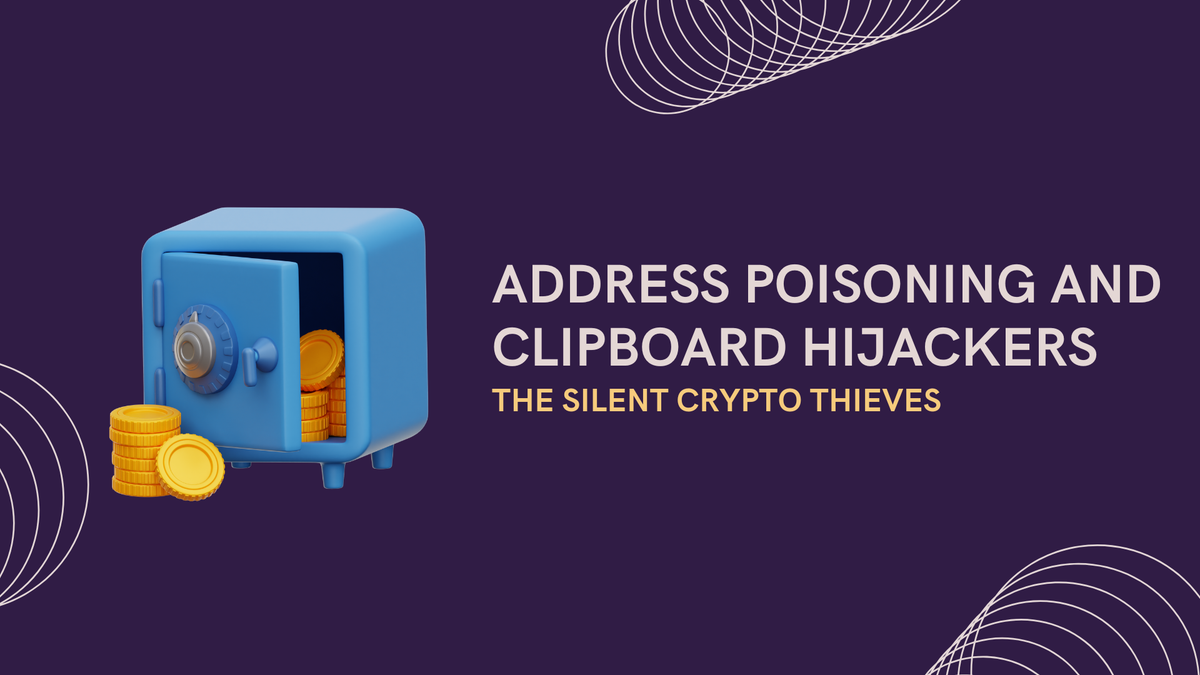Address Poisoning and Clipboard Hijackers: The Silent Crypto Thieves

Cryptocurrency’s promise of decentralized, permissionless finance comes with an ironic vulnerability: the human factor. Address poisoning and clipboard hijacking attacks exploit everyday behaviors, copying and pasting wallet addresses, to siphon off millions in digital assets. These “silent” exploits leave no traces on the blockchain itself; victims only realize something’s amiss when funds vanish.
Understanding Address Poisoning vs. Clipboard Hijacking
Both address poisoning and clipboard hijacking rely on swapping genuine wallet addresses for attacker-owned ones. Attackers exploit human trust in copy-paste processes rather than breaking blockchain cryptography.
- Address poisoning involves injecting lookalike addresses into your transaction history.
- Clipboard hijacking uses malware to monitor your clipboard and replace addresses as you copy them.
Although the vectors differ, the end goal is the same: redirect your crypto to a wallet you don’t control.
How Attackers Manipulate Addresses During Copy-Paste
Attackers employ sophisticated techniques to trick users into sending funds to malicious addresses. Understanding their methods helps you spot anomalies and stay vigilant.
Address Poisoning Tactics
- Vanity and lookalike addresses: Attackers generate addresses matching the first few and last few characters of your intended recipient. Tools like VanityGen make crafting these deceptive strings simple.
- Dusting and breadcrumbing: Tiny or zero-value transfers from attacker-owned addresses appear in your on-chain history. When you browse Etherscan or BscScan, the poisoned address can lure you into copying it for your next transaction.
- Zero-value spoofing: Sending zero-value transactions avoids spending gas on transfers but still seeds the fake address in your activity log. This stealth tactic increases the risk of accidental use.
A high-profile incident in May 2024 saw a crypto whale lose 1,155 WBTC (around $68 million) after copying a lookalike address seeded minutes earlier.
Clipboard Hijacker Mechanics
- Infection vectors: Malicious browser extensions, trojanized desktop applications, and fake mobile apps deliver clipboard-monitoring malware. Fake privacy or utility tools on unofficial stores often contain these threats.
- Clipboard monitoring and swap: The malware runs silently, scanning the clipboard contents for patterns matching Bitcoin (
1…,3…) or Ethereum (0x…) addresses. On detection, it swaps in the attacker’s address and hides its process from casual inspection.
One Android example involved a “Reddit privacy tips” app that replaced BTC addresses on paste, diverting millions before it was removed from Google Play.
Real-World Examples & Impact
In May 2024, a crypto whale lost 1,155 WBTC (approximately $68 million) after copying a lookalike address that had been dusted just minutes before. This incident highlights how zero-value transactions can poison your address book undetected.
In July 2022, Poloniex traders using a trojanized Android app lost $2.3 million in Bitcoin after the app replaced legitimate deposit addresses with attacker-controlled ones. The scam mimicked the official trading gateway to evade suspicion.
During April 2022, a Windows clipboard hijacker known as “CryptoClipper” silently monitored clipboard activity. By swapping valid Bitcoin addresses with malicious ones during copy-paste, it duped numerous users into unknowingly sending funds to wallets under attacker control.
In March 2025, two back-to-back address-poisoning scams on the BNB Chain siphoned around $2.6 million in USDC through zero-value seeding, exploiting the same lookalike address technique used on Ethereum.
Altogether, confirmed losses from address poisoning on Ethereum and BNB Chain exceed $83 million, demonstrating the high stakes when routine habits go unprotected.
Verifying Addresses: Your First Line of Defense
Before sending any cryptocurrency, treat the destination address string as sacrosanct. Manual checks and specialized tools minimize the risk of error or hijack.
- Full-string comparison: Never trust a partial match. Always verify every character on-screen or on your hardware device.
- Test transactions: Send a minimal amount (e.g., 0.0001 ETH) first to ensure the recipient is correct.
- Blockchain explorers: Paste the address into Etherscan or Bsc Scan to inspect its on-chain history and confirm it belongs to your intended counterparty.
- Risk and reputation checks: Services like StarChecker assign risk scores based on on-chain behavior and scam reports, helping you identify suspicious wallets.
- Name services and address books: Map long hexadecimal addresses to human-readable names via Ethereum Name Service (ENS) or Unstoppable Domains. Store verified contacts in your wallet’s address book to avoid manual copying and pasting.
- Hardware wallet pass-through verification: Devices like Ledger and Trezor display the full destination address on-device. Manually compare every character before confirming any transaction.
Browser Extensions & Tools to Prevent Hijacking
Layer specialized extensions and security tools on top of your wallet to detect swaps, simulate transactions, and block malicious scripts.
- AegisWeb3 Detects phishing sites, analyzes smart contracts for rug pulls, and revokes suspicious dApp permissions.
- Pocket Universe simulates and audits transactions on Ethereum, BSC, Polygon, and Arbitrum. Includes $2,000 insurance for false negatives.
- Wallet Guard Scans URLs for known malicious sites, simulates transactions before signing, and includes a “stormwatcher” module to detect wallet-draining contracts.
- Revoke.cash identifies and revokes token approvals across Ethereum and Layer 2 networks to reduce your attack surface.
- Web3 Antivirus (W3A) Chain-agnostic malware, phishing, and smart contract scanner with real-time alerts.
- Opera Paste Protection Built into the Opera Crypto Browser, this feature tracks clipboard changes after copy and warns if the address has been altered before pasting.
Combine these browser defenses with reputable antivirus suites like Malwarebytes or ESET. Only install crypto-related apps from official stores and avoid unverified APKs.
Best Practices for Address Hygiene
Good habits compound into robust security. Adopt these strategies to minimize risk:
- Rotate addresses frequently: Avoid reusing the same public address. Fresh addresses reduce poisoning and hijacking exposure.
- Use hardware and multi-signature wallets: Store large holdings in cold storage or multi-sig setups. Multiple approvals add an extra layer of defense.
- Leverage blockchain analytics: Tools such as Chainalysis Reactor can flag high-risk wallets before you interact.
- Manage blacklists and whitelists: Maintain lists of trusted and blocked addresses. Enforce whitelists in your wallet interface to restrict outgoing transactions only to known contacts.
Recovering from an Attack
If you suspect you’ve been targeted, swift action is critical:
- Immediate mitigation: Move any uncompromised funds to a fresh wallet. Revoke all dApp approvals using Revoke.cash.
- System cleanup: Run full antivirus and anti-malware scans with tools like Malwarebytes and the Windows Malicious Software Removal Tool.
- Trace and report stolen funds: Use platforms like Verifi Wallet to check if stolen assets landed in known illicit addresses. Contact centralized exchanges if you spot deposits; they may freeze the funds.
Conclusion
Address poisoning and clipboard hijackers prey on routine behaviors rather than blockchain weaknesses. No on-chain patch can reverse these scams once they succeed. Your best defense is meticulous address verification, specialized browser extensions, hardware wallet confirmations, and disciplined operational habits. Stay vigilant, rotate addresses, simulate transactions, and always confirm the full destination string before sending. With the right precautions, you can keep these silent thieves at bay and ensure your crypto stays in your hands.
References
- Chainalysis – Anatomy of an Address Poisoning Scam: https://www.chainalysis.com/blog/address-poisoning-scam/
- Cointelegraph – What are address poisoning attacks in crypto and how to avoid them?: https://cointelegraph.com/news/address-poisoning-attacks-in-crypto
- Etherscan – Ethereum Blockchain Explorer: https://etherscan.io/
- Revoke.cash – Revoke Token Approvals Across Ethereum & Layer-2s: https://revoke.cash/
- CoinGecko – Top Security Browser Extensions to Protect Your Crypto: https://www.coingecko.com/learn/security-browser-extensions-crypto
MITOSIS official links:
GLOSSARY
Mitosis University
WEBSITE
X (Formerly Twitter)
DISCORD
DOCS



Comments ()